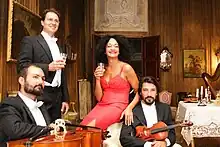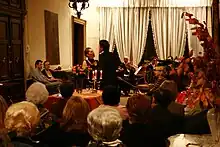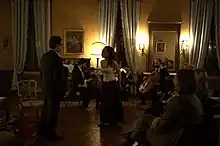
Musica a Palazzo, since 2005, have produced opera performances staged in the Palazzo Barbarigo Minotto, a Venetian Gothic palace facing the Grand Canal. The piano nobile of the palace, with its backdrop of frescoes by Tiepolo and sculptures by Carpoforo Tencalla, is its main performing space.[1] The performing style follows the 19th-century Italian practice of "Salotto Musicale" (Musical Salon). The operas are performed without a stage, with the audience becoming part of the scene.[2][3]
The program alternates famous operas, such as Verdi's La traviata and Rossini's The Barber of Seville,[4] with Duetti d'amore, a selection of love duets from La bohème, Tosca, Don Giovanni, Rigoletto and other popular operas.

The musicians, a string trio and a piano, have performed in concert halls around the world, including Lincoln Center, Musikverein, La Scala and the Mozarteum. The ensemble staged La traviata at the Royal Pavilion during the 41st Brighton Festival[5] and won the Argus Angel Award for the best production of the festival.[6]
Although some other artists might be hired on particular occasions, the original "Musica a Palazzo Ensemble" is formed by:
- Diego Revilla – violin[7]
- Patrizia Di Paolo – viola[8]
- Patrick Monticoli – cello[9]
- Giovanni Dal Missier – piano[10]

Reviews
- Press
- The Daily Telegraph – "We are captivated by the quality of the music, the splendour of the setting (Tiepolo frescoes), the power and passion of the singing..."[11]
- The Times – "Grand opera reconceived as tea-room tinkle..."[12]
- Il Gazzettino – "Wonderful stuccos tinted by time and frescos are the perfect frame for a dive into the past, on the notes of romantic and ravishing musics."
- Weltexpress – "Four musicians succeed in what usually takes a whole orchestra ... this is a whole new experience, to experience great voices and strong emotions so closely."
- The Argus[13] – "This Opera of love and loss is totally stunning, fully engaging and sometimes raises the hairs on the back of your neck."
- Guide books
- Lonely Planet – "Venice"
- Bootsnall – "Venice"
- Chiavi d’oro delle tre venezie – "Un ospite a Venezia"
- Marco Polo – "Venedig"
- La guide de Routard – "Venice"
- Time Out – "Venice, Verona, Treviso & the Veneto"
- Condé Nast – "Traveller"
- Meridiani – "Laguna veneta"
References
- ↑ Simonis, Damien, Italy, Lonely Planet, 2010 p. 378. ISBN 1-74179-229-0
- ↑ Millirons, Eric, "More to explore than canals in Venice", Midlothian Exchange (Virginia, USA), July 1, 2008
- ↑ Bing, Alison, Venice Encounter, Lonely Planet, 2009, p. 56. ISBN 1-74104-997-0
- ↑ Shields, Daisy, "Lose yourself in the misty magic of Venice in winter" Archived 2011-09-29 at the Wayback Machine, Hampstead & Highgate Express, 18 December 2009
- ↑ The Argus, Review: La Traviata, Royal Pavilion, Brighton, 6 May 2007.
- ↑ The Argus, "The cast of La Traviata receive their Angel Award from The Argus's Adrian Varma", 9 May 2007
- ↑ "Diego Revilla | Musica a Palazzo". Archived from the original on 2011-07-22. Retrieved 2010-11-10.
- ↑ "Patrizia di Paolo | Musica a Palazzo". Archived from the original on 2011-07-22. Retrieved 2010-11-10.
- ↑ "Patrick Monticoli | Musica a Palazzo". Archived from the original on 2011-07-22. Retrieved 2010-11-10.
- ↑ "Giovanni Dal Missier | Musica a Palazzo". Archived from the original on 2011-07-22. Retrieved 2010-11-10.
- ↑ Bridge, Adrian (6 May 2006). "Take a Bow, Venezia". The Daily Telegraph.
- ↑ Morrison, Richard (7 May 2007). "La traviata". The Times.
- ↑ "Palace to be venue for Verdi's opera". 4 May 2007.